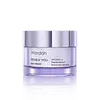What's inside
What's inside
 Key Ingredients
Key Ingredients

 Benefits
Benefits

 Concerns
Concerns

No concerns
 Ingredients Side-by-side
Ingredients Side-by-side

Bakuchiol
AntimicrobialNiacinamide
SmoothingPalmitoyl Pentapeptide-4
Skin ConditioningWater
Skin ConditioningEthylhexyl Methoxycinnamate
UV AbsorberBiosaccharide Gum-1
HumectantPropylene Glycol
Humectant4-Methylbenzylidene Camphor
UV AbsorberCetyl Alcohol
EmollientGlycerin
HumectantGlyceryl Stearate
EmollientPolyacrylamide
Butyl Methoxydibenzoylmethane
UV AbsorberDimethicone
EmollientPhenoxyethanol
PreservativeCyclopentasiloxane
EmollientStearic Acid
CleansingPEG-100 Stearate
Butylene Glycol
HumectantC13-14 Isoparaffin
EmollientHydrolyzed Wheat Protein/Pvp Crosspolymer
Parfum
MaskingLaureth-7
EmulsifyingDimethicone Crosspolymer
Emulsion StabilisingEthylhexylglycerin
Skin ConditioningAllantoin
Skin ConditioningResveratrol
AntioxidantTocopheryl Acetate
AntioxidantDisodium EDTA
Sodium Hyaluronate
HumectantCarbomer
Emulsion StabilisingDimethicone/Vinyl Dimethicone Crosspolymer
Skin ConditioningPolysorbate 20
EmulsifyingPotassium Sorbate
PreservativeEDTA
Dimethiconol
EmollientPalmitoyl Oligopeptide
CleansingPalmitoyl Tetrapeptide-7
Skin ConditioningBakuchiol, Niacinamide, Palmitoyl Pentapeptide-4, Water, Ethylhexyl Methoxycinnamate, Biosaccharide Gum-1, Propylene Glycol, 4-Methylbenzylidene Camphor, Cetyl Alcohol, Glycerin, Glyceryl Stearate, Polyacrylamide, Butyl Methoxydibenzoylmethane, Dimethicone, Phenoxyethanol, Cyclopentasiloxane, Stearic Acid, PEG-100 Stearate, Butylene Glycol, C13-14 Isoparaffin, Hydrolyzed Wheat Protein/Pvp Crosspolymer, Parfum, Laureth-7, Dimethicone Crosspolymer, Ethylhexylglycerin, Allantoin, Resveratrol, Tocopheryl Acetate, Disodium EDTA, Sodium Hyaluronate, Carbomer, Dimethicone/Vinyl Dimethicone Crosspolymer, Polysorbate 20, Potassium Sorbate, EDTA, Dimethiconol, Palmitoyl Oligopeptide, Palmitoyl Tetrapeptide-7
Water
Skin ConditioningGlycerin
HumectantSqualane
EmollientPropanediol
SolventPanthenol
Skin ConditioningCeramide NP
Skin ConditioningChlorphenesin
AntimicrobialPolyacrylate Crosspolymer-6
Emulsion StabilisingCaprylic/Capric Triglyceride
MaskingPhytol
EmollientIsomalt
HumectantButylene Glycol
HumectantSodium Hyaluronate
HumectantPentylene Glycol
Skin ConditioningPistacia Lentiscus Gum
MaskingLecithin
EmollientGlyceryl Caprylate
EmollientPotassium Hyaluronate
Skin ConditioningSodium Hyaluronate Crosspolymer
HumectantSodium Acetylated Hyaluronate
HumectantHydroxypropyltrimonium Hyaluronate
Hydrolyzed Hyaluronic Acid
HumectantHyaluronic Acid
HumectantHydrolyzed Sodium Hyaluronate
Skin ConditioningClitoria Ternatea Flower Extract
Skin ConditioningAcetyl Hexapeptide-8
HumectantWater, Glycerin, Squalane, Propanediol, Panthenol, Ceramide NP, Chlorphenesin, Polyacrylate Crosspolymer-6, Caprylic/Capric Triglyceride, Phytol, Isomalt, Butylene Glycol, Sodium Hyaluronate, Pentylene Glycol, Pistacia Lentiscus Gum, Lecithin, Glyceryl Caprylate, Potassium Hyaluronate, Sodium Hyaluronate Crosspolymer, Sodium Acetylated Hyaluronate, Hydroxypropyltrimonium Hyaluronate, Hydrolyzed Hyaluronic Acid, Hyaluronic Acid, Hydrolyzed Sodium Hyaluronate, Clitoria Ternatea Flower Extract, Acetyl Hexapeptide-8
 Reviews
Reviews

Ingredients Explained
These ingredients are found in both products.
Ingredients higher up in an ingredient list are typically present in a larger amount.
Butylene Glycol (or BG) is used within cosmetic products for a few different reasons:
Overall, Butylene Glycol is a safe and well-rounded ingredient that works well with other ingredients.
Though this ingredient works well with most skin types, some people with sensitive skin may experience a reaction such as allergic rashes, closed comedones, or itchiness.
Learn more about Butylene GlycolGlycerin is already naturally found in your skin. It helps moisturize and protect your skin.
A study from 2016 found glycerin to be more effective as a humectant than AHAs and hyaluronic acid.
As a humectant, it helps the skin stay hydrated by pulling moisture to your skin. The low molecular weight of glycerin allows it to pull moisture into the deeper layers of your skin.
Hydrated skin improves your skin barrier; Your skin barrier helps protect against irritants and bacteria.
Glycerin has also been found to have antimicrobial and antiviral properties. Due to these properties, glycerin is often used in wound and burn treatments.
In cosmetics, glycerin is usually derived from plants such as soybean or palm. However, it can also be sourced from animals, such as tallow or animal fat.
This ingredient is organic, colorless, odorless, and non-toxic.
Glycerin is the name for this ingredient in American English. British English uses Glycerol/Glycerine.
Learn more about GlycerinSodium Hyaluronate is hyaluronic acid's salt form. It is commonly derived from the sodium salt of hyaluronic acid.
Like hyaluronic acid, it is great at holding water and acts as a humectant. This makes it a great skin hydrating ingredient.
Sodium Hyaluronate is naturally occurring in our bodies and is mostly found in eye fluid and joints.
These are some other common types of Hyaluronic Acid:
Learn more about Sodium HyaluronateWater. It's the most common cosmetic ingredient of all. You'll usually see it at the top of ingredient lists, meaning that it makes up the largest part of the product.
So why is it so popular? Water most often acts as a solvent - this means that it helps dissolve other ingredients into the formulation.
You'll also recognize water as that liquid we all need to stay alive. If you see this, drink a glass of water. Stay hydrated!
Learn more about Water